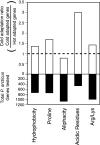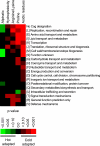The genome sequence of Psychrobacter arcticus 273-4, a psychroactive Siberian permafrost bacterium, reveals mechanisms for adaptation to low-temperature growth
- PMID: 20154119
- PMCID: PMC2849256
- DOI: 10.1128/AEM.02101-09
The genome sequence of Psychrobacter arcticus 273-4, a psychroactive Siberian permafrost bacterium, reveals mechanisms for adaptation to low-temperature growth
Abstract
Psychrobacter arcticus strain 273-4, which grows at temperatures as low as -10 degrees C, is the first cold-adapted bacterium from a terrestrial environment whose genome was sequenced. Analysis of the 2.65-Mb genome suggested that some of the strategies employed by P. arcticus 273-4 for survival under cold and stress conditions are changes in membrane composition, synthesis of cold shock proteins, and the use of acetate as an energy source. Comparative genome analysis indicated that in a significant portion of the P. arcticus proteome there is reduced use of the acidic amino acids and proline and arginine, which is consistent with increased protein flexibility at low temperatures. Differential amino acid usage occurred in all gene categories, but it was more common in gene categories essential for cell growth and reproduction, suggesting that P. arcticus evolved to grow at low temperatures. Amino acid adaptations and the gene content likely evolved in response to the long-term freezing temperatures (-10 degrees C to -12 degrees C) of the Kolyma (Siberia) permafrost soil from which this strain was isolated. Intracellular water likely does not freeze at these in situ temperatures, which allows P. arcticus to live at subzero temperatures.
Figures



References
-
- Adekoya, O. A., R. Helland, N. P. Willassen, and I. Sylte. 2006. Comparative sequence and structure analysis reveal features of cold adaptation of an enzyme in the thermolysin family. Proteins Struct. Funct. Bioinformatics 62:435-449. - PubMed
-
- Altschul, S. F., W. Gish, W. Miller, E. W. Myers, and D. J. Lipman. 1990. Basic local alignment search tool. J. Mol. Biol. 215:403-410. - PubMed
-
- Badger, J. H., and G. J. Olsen. 1999. CRITICA: coding region identification tool invoking comparative analysis. Mol. Biol. Evol. 16:512-524. - PubMed
-
- Bakermans, C., H. L. Ayala-del-Rio, M. A. Ponder, T. Vishnivetskaya, D. Gilichinsky, M. F. Thomashow, and J. M. Tiedje. 2006. Psychrobacter cryohalolentis sp. nov. and Psychrobacter arcticus sp. nov., isolated from Siberian permafrost. Int. J. Syst. Evol. Microbiol. 56:1285-1291. - PubMed
-
- Bakermans, C., C. Sloup, D. Zarka, J. M. Tiedje, and M. F. Thomashow. 2009. Development and use of genetic system to identify genes required for efficient low-temperature growth of Psychrobacter arcticus 273-4. Extremophiles 13:21-30. - PubMed
Publication types
MeSH terms
Substances
Associated data
- Actions
LinkOut - more resources
Full Text Sources
Other Literature Sources
Molecular Biology Databases
Miscellaneous

